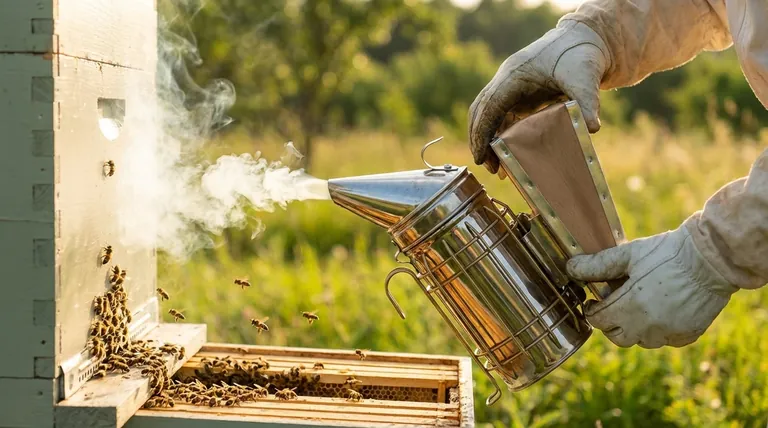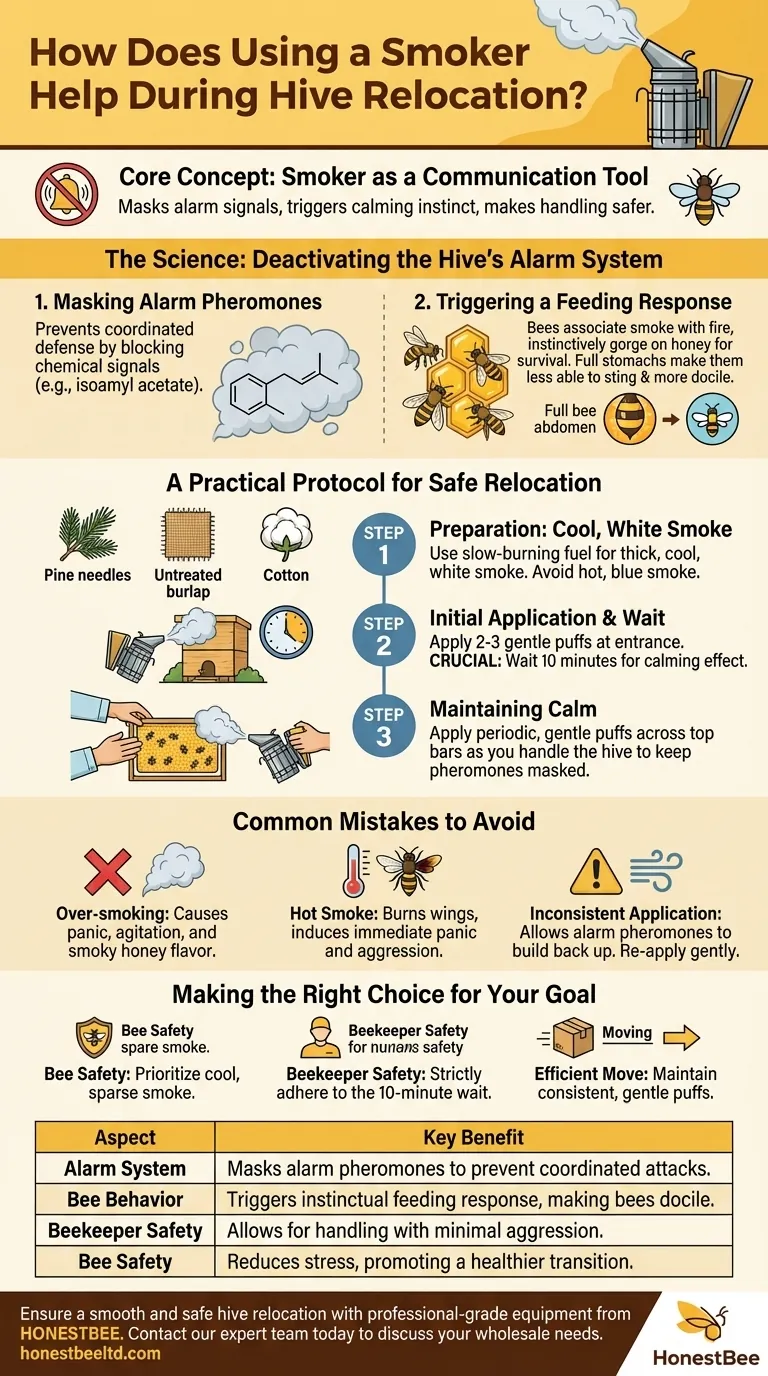At its core, a bee smoker is a communication tool used to manage a honeybee colony's defensive response. During a hive relocation, it masks the bees' primary alarm signal and triggers a calming, instinctual behavior, making the entire process significantly safer for both the beekeeper and the bees. The smoke interrupts their ability to coordinate a defense, allowing you to handle the hive with minimal stress and aggression.
The smoker's true function is not to subdue the bees, but to disrupt their communication. By masking alarm pheromones and encouraging a natural feeding response, you are temporarily overriding their defensive instincts, which is essential for a successful and low-stress hive relocation.

The Science of Smoke: Deactivating the Hive's Alarm System
To use a smoker effectively, you must understand the two primary biological responses it triggers in a honeybee colony.
Masking Alarm Pheromones
When a honeybee perceives a threat or is crushed, it releases alarm pheromones. The most potent of these is isoamyl acetate, which smells like bananas.
This chemical signal instantly alerts other guard bees, broadcasting the location of the threat and triggering a coordinated defensive attack. Smoke effectively masks these pheromones, making it impossible for the bees to organize a large-scale defensive response.
Triggering a Feeding Response
Bees have an instinctual response to smoke, which they associate with a forest fire threatening their hive. Their immediate priority becomes survival.
This triggers an impulse to gorge on honey, preparing to abscond with as many resources as possible. A bee with a full stomach is physically less able to flex its abdomen to sting and is generally more docile, focusing on its full belly rather than the perceived threat from the beekeeper.
A Practical Protocol for Using a Smoker During Relocation
Proper technique is critical. The goal is to create a calm atmosphere, not to fill the hive with thick, hot smoke.
Preparation: Lighting and Fuel
The quality of your smoke matters. You need cool, thick, white smoke.
Ensure your smoker is filled with a slow-burning fuel, such as pine needles, untreated burlap, or cotton. Pump the bellows until the fire is smouldering well and producing cool smoke. Hot, blueish smoke can burn and agitate the bees.
The Initial Application
Approach the hive gently. Direct two or three gentle puffs of smoke into the hive entrance.
Then, wait. This is a crucial step. Allow up to 10 minutes for the smoke to circulate and for the bees to begin consuming honey. This waiting period is what truly pacifies the colony.
Maintaining Calm During Handling
After waiting, gently open the hive lid and apply a few more puffs across the top of the frames.
As you work to secure the hive for movement, apply periodic, gentle puffs as needed, especially in areas of high bee density. The goal is consistent but sparse application to keep the alarm pheromones masked.
Understanding the Trade-offs: Common Mistakes to Avoid
Using a smoker incorrectly can be more disruptive than using no smoke at all. Understanding the potential pitfalls is key to building trust with your bees.
Over-smoking: From Calm to Agitation
Blasting the hive with excessive smoke is counterproductive. It can cause bees to panic and become agitated or overly stressed. It can also impart a smoky flavor to the honey if done too heavily.
Hot Smoke: A Costly Error
Never use a smoker that is billowing hot, blue smoke. This can burn the bees' delicate wings and cause immediate panic and aggression. If you can't hold your hand comfortably in the smoke, it's too hot for the hive.
Inconsistent Application
Applying smoke once at the beginning of a long procedure is not enough. The effect of the smoke wears off, and alarm pheromones can quickly build back up. Gentle, periodic re-application is essential for maintaining control.
Making the Right Choice for Your Goal
Your primary objective dictates how you should focus your smoker technique during a hive relocation.
- If your primary focus is bee safety: Prioritize using cool, white smoke sparingly to mask pheromones without causing physical harm or undue stress from over-smoking.
- If your primary focus is beekeeper safety: Adhere strictly to the 10-minute waiting period after the initial puffs to ensure the bees' feeding response has fully engaged, making them less inclined to fly or sting.
- If your primary focus is a smooth, efficient move: Focus on maintaining a consistently calm atmosphere with periodic, gentle puffs to prevent the hive's defensive response from escalating as you work.
Used with understanding, the smoker transforms from a simple tool into your most effective means of communicating calm to the entire colony.
Summary Table:
| Aspect | Key Benefit |
|---|---|
| Alarm System | Masks alarm pheromones (e.g., isoamyl acetate) to prevent coordinated bee attacks. |
| Bee Behavior | Triggers an instinctual feeding response, making bees docile and less likely to sting. |
| Beekeeper Safety | Allows for handling the hive with minimal aggression during the moving process. |
| Bee Safety | Reduces stress on the colony, promoting a healthier transition to the new location. |
Ensure a smooth and safe hive relocation with professional-grade equipment from HONESTBEE.
As a trusted wholesale supplier for commercial apiaries and beekeeping equipment distributors, we provide the reliable tools you need for effective hive management. Our smokers and other essential supplies are designed to help you work confidently and keep your colonies calm.
Contact our expert team today to discuss your wholesale needs and discover how HONESTBEE can support the success and safety of your beekeeping operations.
Visual Guide

Related Products
- Stainless Steel Honey Bee Smoker Hive and Honeycomb Smoker for Beekeeping
- Premium Traditional Copper Bee Smoker with Bellows
- European Stainless Steel Bee Smoker for Honey Bee Hive
- Stainless Steel Bee Hive Smoker Beekeeping Smoker for Wholesale
- Economy Galvanized Beekeeping Honey Bee Smoker for Wholesale
People Also Ask
- How long does it take to clean a bee smoker? From 15-Minute Quick Fix to 10-Hour Deep Clean
- What happens to bees when they sense smoke? Unlock the Secret to Calm Hive Inspections
- What is a bee smoker and what is its primary purpose? Master Safe Hive Inspections
- What is the primary purpose of using smoke in beekeeping? Calm Bees for Safer Hive Management
- What is the purpose of a bee smoker and how should it be used? A Guide to Calm, Safe Hive Inspections



















